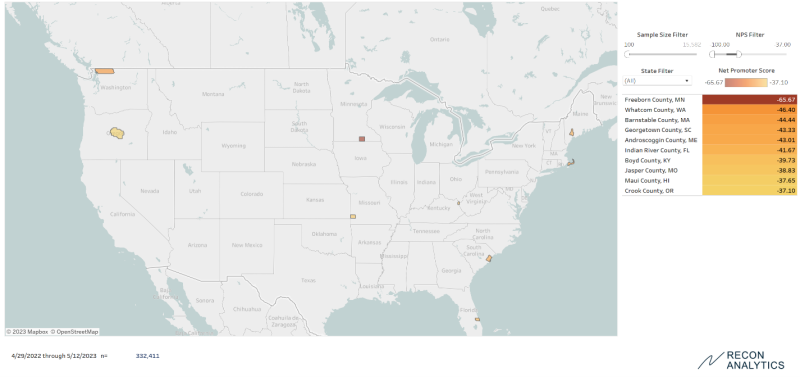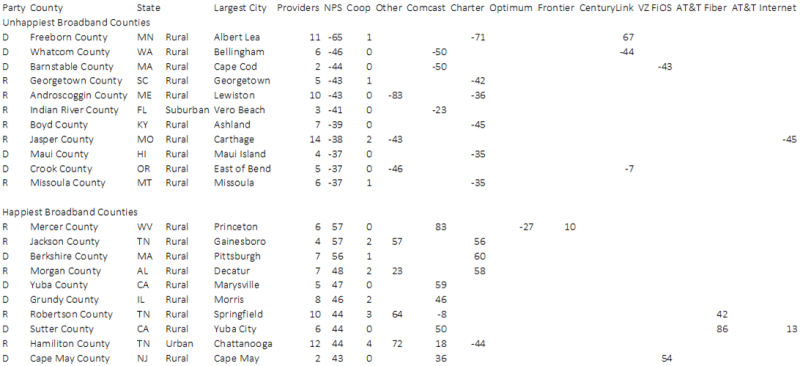Recon Analytics’ new data on the happiest and unhappiest broadband counties in the U.S paints a surprising picture of inconsistency across the nation’s rural areas that is mostly caused by “local execution,” said Recon Founder Roger Entner.
Nine out of 10 of the unhappiest broadband counties are rural, and the same number of the happiest counties are also rural – a juxtaposition that boils down to efforts by local groups and providers in each territory.
Entner said that he would have assumed some of the unhappiest counties in the country would be urban areas, where the larger populations are more ethnically diverse and younger (those demographics typically show higher expectations and lower scores, he noted) but “the extremes were in rural America.”
“The idea that urban markets get all the investment because they are densely populated and cheaper to service, and therefore have the happiest broadband customers, is just not reflected in the data,” Entner wrote in his analysis. “At the same time, the rival argument that urban areas are dystopic wastelands with horrible broadband service is equally not supported by the data.”
Recon surveyed more than 330,000 respondents across dimensions such as their browsing experience, streaming audio/video experience, installation, adding new devices to the network, technical support, value for price and how easy it is to use their provider’s website.
Entner said he was surprised to find that results didn’t depend on whether areas were rich in cable versus fiber versus DSL, either. “I was almost dreading to find the same results as we find in aggregate surveys: that steel-wired armour (SWA) fiber customers are all the most satisfied, followed by fiber, followed by cable, followed by DSL, but what I found is really interesting – that’s like a dead horse story,” he added.

Among the ten unhappiest counties, Recon data showed that in some have fiber coverage in every ZIP-code, such as Georgetown County, South Carolina and Indian River County, FL. But other unhappy counties, like Barnstable County, MA, didn’t have fiber in any of their ZIP-codes.
“These types of systemic, technology-driven or industry structural reasons are not providing the answer, despite being commonly accepted truths,” Entner said in his analysis.
5G fixed wireless service did not make an impact on the happiest and unhappiest broadband counties. In some counties where there is 5G fixed wireless service, the adoption numbers were so low that they didn’t make an impact on the overall happiness of broadband customers.
Notably, the Recon data revealed another misconception that counties with broadband cooperatives should produce better scores. In four of the ten unhappiest counties, member-owned co-ops -- which are typically non-profits -- were active.
In six of the ten happiest counties, co-ops are active, but not in the happiest broadband county, Mercer County, WV, so the Recon study didn’t show a significant correlation between the presence of such organizations and the broadband scores in their county.
“Co-ops, they're nonprofits and a lot of the talk inside the beltway is that nonprofits like cooperatives are going to provide better service and better quality because they don't have a profit incentive. And we don't find the data at all. There are some nonprofits that are awesome. And then there are other co-ops that aren't,” Entner said.

In the end, what matters is execution on a case by case basis.
“All of the things for the national providers are the same, the pricing is the same, the product lineup is the same. But the differences were remarkable,” Entner told Fierce. “It didn't matter if it was cable if it was DSL or if it was fiber. When you look at Verizon, Verizon is typically an excellent company. I am a Verizon Fios customer, and I'm happy, over the moon with them. But if you live in Barnstable with a Verizon implementation, you're not.”
Providers lack consistency
The ten unhappiest counties are being served by two providers (in Barnstable County, MA) all the way up to 14 providers (Jasper County, MO), “which tells us that limited or significant choice is not a driver of unhappiness, especially when all of the counties are served by all technologies from fiber to DSL,” the Recon analysis noted.
Entner pointed out that it’s not only regional providers who are responsible for the disparate scores across rural areas. Larger companies are showing wide variations in their scores across rural customers too.
Almost all providers showed inconsistency in the Recon data, meaning the same provider that performed well in some counties performed poorly in others. For example, Comcast’s “exceptionally good” performance made Mercer County, WV the happiest broadband county, and its poor performance in Barnstable County, MA and Whatcom County, WA made them the second and third unhappiest broadband counties.
Only AT&T Fiber performed consistently well in the ten happiest counties and was not present in the unhappiest.
“The providers need to do a better job. It comes down to the fundamentals. It's building a network that's resilient and fast at a reasonable price and customers will love you. And if you don't, they don't. Just do your job,” Entner said.
Ultimately, Recon found that what really matters is the individual performance of a provider in each county. The firm accumulated the NPS scores for the providers with at least 20 respondents in each county where the survey had at least 100 respondents.

According to Entner, providers can improve their customer experience by internally benchmarking performance and extending best practices throughout the entire organization.
Regulators should look at how satisfied their customers are before allocating broadband subsidies to providers. “If they have multiple applicants for subsidies, they should be given to the providers who deliver for the taxpayers, who provided the funds through taxes in the first place,” Entner said in his analysis.
Entner added, “Our research shows that every provider is able to do excellent work and make their customers happy...technology helps, but the key is local execution.”
